Are Ghost Kitchens Helping or Harming Independent Restaurants?

Within the past two years, the number of restaurants in the US that offer online delivery has grown by an incredible 210%. Given this rapid increase, it’s not surprising that attitudes and business practices related to online ordering are transforming quickly, too. Many online delivery apps are no longer content to just provide ordering technology and delivery services. They’re encroaching further and further into the restaurant business itself by opening up what are known as ‘ghost kitchens.’
Ghost kitchens—also called virtual restaurants or virtual kitchens—are restaurant concepts that operate without any kind of storefront and only fulfill orders through online ordering apps. Here’s what restaurateurs like you need to know about them.
How and why do delivery apps open up ghost kitchens?
Ghost kitchens typically come about when a third-party food delivery app like Grubhub or Uber Eats analyzes its restaurant data in a given market and sees that there’s an unfulfilled demand for a certain type of cuisine.
Representatives from the third-party app will then approach restaurateurs and chefs that are already using their platforms, and ask them to create a side business to serve the in-demand food.
For Uber Eats, Grubhub, Postmates, and other third-parties, this phenomenon just means more sales. According to Eater, “The virtual restaurant-within-a-restaurant model relies on space that’s already provided by their restaurant clients, meaning the delivery companies aren’t on the hook to provide commissary kitchen space—and can still collect on their hefty service fees.”
Some businesses go beyond this virtual restaurant-within-a-restaurant setup and opt to use commissary-style spaces that brand themselves as “cloud kitchens.” These kitchens can be run out of warehouse spaces or even shipping containers. While certain delivery apps experiment with the cloud kitchen model, there are also whole companies dedicated to developing and renting these spaces.
Many virtual concepts have exclusive distribution deals with a specific delivery app, meaning that you can’t shop around to get the best deal for your business—let alone break free and use your own online ordering system. The third-party marketplace simply lists your concept, tells you what to cook, and delivers the food, all while taking your restaurant’s data and up to 40% of each check.
So, what’s in it for restaurateurs?
There are several reasons why some restaurateurs are enthusiastic about ghost kitchens. They can offer the opportunity to test new concepts and recipes more easily, and aren’t nearly as capital-intensive to launch as a regular restaurant. However, the two largest draws—the promises of lower overhead and increased sales—are potentially the most problematic.
The Overhead Issue
All things considered, delivery-only concepts operated out of commissary-style kitchens have lower overhead, at least when it comes to operating costs like rent and wages. Factor in the cost of delivery app commissions, though, and profits shrink.
The ‘virtual restaurant-within-a-restaurant’ model for ghost kitchens is more common and poses even more financial challenges, namely because it doesn’t reduce overhead.
Restaurant delivery marketplaces will have you believe that all of your online ordering sales—including those through a virtual restaurant—are ‘incremental,’ meaning you wouldn’t have gotten them otherwise. Delivery apps contend that if your cooks are already cooking and you’re already paying the rent, you can exclude these ‘fixed’ costs when calculating the profitability of those incremental, commission-based online ordering sales.
This logic is faulty. Whether you’re preparing a to-go order or a dine-in meal, you’re still using electricity, wearing out your equipment, and paying your staff. Simply put, if you’re operating a ghost kitchen out of your existing restaurant, you’re not cutting down on overhead.
Do more orders make up for lower margins?
Ghost kitchens are usually designed to supply an unfulfilled demand for a certain type of cuisine in a given area. It makes sense, then, that opening one might lead to a considerable increase in sales.
However, if you pay up to 40% commission on every online order, you’re actively eating into your budget. Every restaurant’s finances are different, but it’d be surprising if the majority of restaurateurs made a healthy profit operating a virtual kitchen.
Even venture capitalists are sounding the warning bell for independent restaurants. According to Michael Moritz of Sequoia Capital, “In some markets there is still an opportunity for hardened restaurant and kitchen operators — particularly if they are gifted in the use of social media, to build a following and refashion themselves. But they need to move quickly before it becomes too expensive to compete with the larger, faster-moving companies.”
What does the future look like for independent restaurants?
Ghost kitchens are already distorting customers’ digital demand for takeout, and things are just heating up.
Companies like Uber Eats and UK-based Deliveroo are seeing sales skyrocket with the virtual restaurant-within-a-restaurant model. Most delivery apps are also experimenting with their own commissary kitchens, and money is pouring into cloud kitchen ventures.
Industry experts are concerned that these third-party marketplaces and cloud kitchen players won’t be content to just provide kitchen spaces and delivery services. Documentary filmmaker Matt Newberg notes, “Technologists are not interested in being real estate players. These tech companies get footholds in certain markets, in order to leverage them into something larger. This is just the first step.”
While these fears haven’t played out yet, some worry that cloud kitchen companies and third-party marketplaces will use the data they gather to eventually copy and replace the concepts they work with.
One thing that is certain is restaurants’ increasing dependence on third-party apps. As one restaurateur who operates a ghost kitchen on Uber Eats puts it, “They took away the phone business. Without them now, we don’t have any business.”
There’s still hope.
You don’t need to be afraid of technology. Rather, you should use it to fight back against greedy middlemen. Take back your profits, customers, and data by getting your restaurant its very own commission-free online ordering system with ChowNow.





